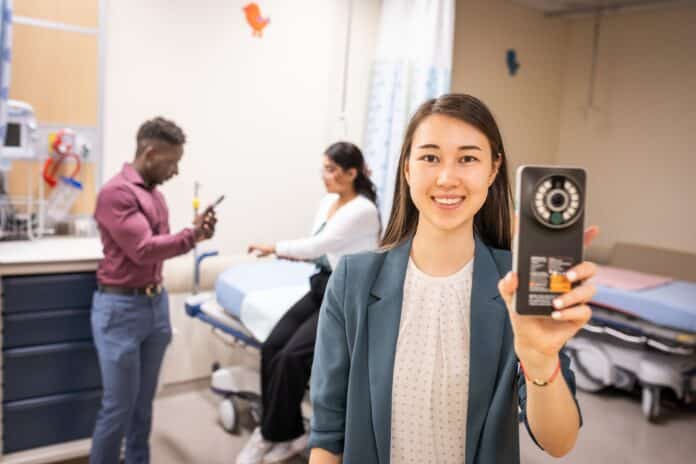HN Summary
• Promising new tool: MHamilton Health Sciences (HHS) is testing the Canadian-made handheld imaging device MIMOSA Pro, which can detect early, under-the-skin signs of pressure injuries before they become visible, potentially improving patient outcomes.
• Study findings so far: In over 3,500 patient assessments, the MIMOSA Pro correctly ruled out pressure injury risk in adults 91% of the time, compared to 40% with the Braden Scale, and showed similar accuracy to the Braden QD in pediatric patients.
• Equity and next steps: HHS aims to determine if MIMOSA Pro is more effective than current tools at detecting pressure injuries in patients with darker skin tones, supporting its health equity and patient safety priorities.
A portable, advanced handheld skin imaging device being tested by Hamilton Health Sciences (HHS) is proving to be highly effective in spotting very early signs of pressure injuries in patients, even when damage is starting to form under the skin and can’t yet be seen by the naked eye.
A pressure injury, also called a pressure ulcer or bedsore, is damage to skin and tissue under a bony part of the body that has been pressed against a surface, such as a mattress or wheelchair. They happen when patients aren’t able to shift their weight, and the skin starts to break down.
Pressure injuries are a challenge for hospitals, especially with higher-risk patients like older adults, and patients who are bedridden or in wheelchairs. Wounds from pressure injuries can lead to longer hospital stays, infection, amputation and even death.
Ontario start-up develops promising device
The pilot study was launched last year at HHS to evaluate whether this Canadian-made, pocket-sized Class II medical imaging device (the same class as an ultrasound or x-ray) called the MIMOSA Pro could outperform the current, national standard practice of visually inspecting patients’ skin for signs of pressure injuries using a kind of checklist with scoring called the Braden Scale in adults, and a version called the Braden QD for children.
HHS is especially interested in discovering whether the MIMOSA Pro can bring more equitable care to patients, by being better than the Braden Scale and Braden QD at detecting early signs of pressure injuries in people with dark skin tones. The study is ongoing, and additional data is needed to understand whether the MIMOSA Pro is a more effective tool for this patient population, says Ari Collerman, an HHS chief of interprofessional practice, and the study’s lead.
Researching solutions
Thousands of patients at HHS’ Juravinski Hospital and Cancer Centre, Hamilton General Hospital, St. Peter’s Hospital, West Lincoln Memorial Hospital and McMaster Children’s Hospital (MCH) are taking part in the study.
Initial results from a four-month period, which included over 3,500 patient assessments, found that the MIMOSA Pro correctly identified the lack of early signs of pressure injuries in adult patients 91 per cent of the time, compared to 40 percent using the Braden Scale.
“In an analysis of how well the tools ruled out patients not at risk, the Braden QD used in pediatrics performed similarly to the MIMOSA device,” says Collerman, adding, “The Braden QD correctly identified patients who were not at risk of developing pressure injuries 93.95 per cent of the time, compared to 90.76 per cent with the MIMOSA device.”
While it’s too early to tell whether the MIMOSA Pro is a better tool for patients with dark skin pigmentation, HHS teams hope to have a clearer picture as more patients take part in the study.
“We want to answer the question, ‘Does the MIMOSA Pro help us identify pressure injury signs earlier than the Braden Scale and Braden QD in patients with dark skin tones?’” says Collerman. “That’s our ultimate goal moving forward.”
Braden Scales 101
Using the Braden Scale and Braden QD checklists, nurses examine how the skin looks and feels, whether the patient has pain or moisture on their skin, how easily they can move around, if there’s friction, and even their nutrition. The MIMOSA Pro device, which is held over a patient’s skin, can identify signs below the skin’s surface that aren’t yet visible with this traditional skin check.
“Our teams found the MIMOSA Pro to be very easy and straightforward to use,” says Collerman, adding that better detection allows for early intervention, and could also save health-care teams from doing extra steps that aren’t needed, like turning patients frequently, and applying unnecessary treatments.
Driven by EDI
“HHS is committed to health equity,” says Collerman. “We’re looking for a tool that performs better than the Braden Scale for identifying signs of pressure injuries in patients with dark skin tones. Through this study, we’re hoping to discover whether the MIMOSA Pro is a better tool for identifying early signs of pressure injuries in this patient population.”
Preventing hospital-acquired pressure injuries and sepsis are strategic priorities for HHS, as is equity, diversity and inclusion.
HHS was connected with the device’s developer, MIMOSA Diagnostics Inc., through its partnership with the Coordinated Accessible National (CAN) Health Network, a national organization working to accelerate the adoption of Canadian innovation across the country, drive economic growth and improve health care for Canadians.
The CAN Health Network is supporting the project between HHS and MIMOSA, looking at whether the MIMOSA Pro is more effective in detecting early signs of pressure injuries, including in dark skin pigmentation.
By Lisa Diebel
Lise Diebel works in communications at HHS.

